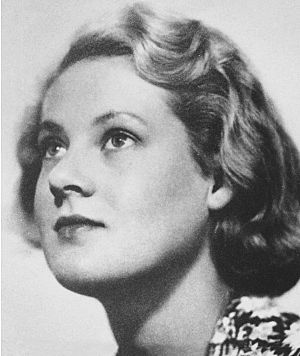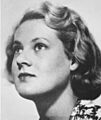Joy Hester facts for kids
Quick facts for kids
Joy Hester
|
|
|---|---|

Hester
|
|
| Born |
Joy St Clair Hester
21 August 1920 Melbourne, Victoria, Australia
|
| Died | 4 December 1960 (aged 40) Melbourne, Victoria, Australia
|
| Nationality | Australian |
| Known for | Painting and drawing |
| Movement | Angry Penguins |
| Spouse(s) | Albert Tucker (1941–1947) Gray Smith (1959–) |
Joy St Clair Hester (born August 21, 1920 – died December 4, 1960) was an important Australian artist. She was a member of the Angry Penguins movement and the Heide Circle. These groups were key in developing Australian Modernism, which is a style of art that broke away from traditional ways.
Hester is famous for her bold and expressive ink drawings. Her art often showed strong feelings. This was partly because her father died when she was young. She also faced a serious illness called Hodgkin's disease. Some of her most famous works include the series Face, Sleep, and Love (from 1948–49). Later, she created The Lovers (from 1956–58).
Contents
Biography
Early life and art training
Joy Hester was born on August 21, 1920. She grew up in Elwood, a suburb of Melbourne, Australia. Her parents were Louise and Robert Hester. When Joy was twelve, her father died from a heart attack.
Joy started studying art at a young age. She attended St Michael's Grammar School from 1933 to 1937. At 17, she studied Commercial Art for a year. Then, she went to the National Gallery School in Melbourne. Even though her classes taught traditional art, Joy liked to try new things. In 1938, she won a prize for drawing a head from a live model. Her early work focused on shadows and how light and dark worked together.
The Heide Circle and Angry Penguins
In 1938, Joy met another artist named Albert Tucker. They began living together sometimes in East Melbourne. That same year, Joy helped start the Contemporary Art Society (CAS). She showed her art with them every year.
In 1939, Joy met Sunday Reed, an art supporter from Melbourne. They became good friends. Sunday helped Joy with her art. Joy spent a lot of time at Heide with Sunday and her husband John Reed. This group of artists and supporters was known as the Heide Circle. Joy was friends with famous artists like Sidney Nolan, Arthur Boyd, and Charles Blackman.
The Heide Circle was closely linked to the Angry Penguins magazine. This magazine was important for modern art in Australia. Joy Hester was the only woman artist whose work was shown in the Angry Penguins publication.
In the early 1940s, Joy started drawing everyday scenes. She made ink drawings of street life and factory workers. She was inspired by artist Ailsa O'Connor. Joy also admired artist Danila Vassilieff. He believed that art and life should always be connected.
By the mid-1940s, Joy stopped using oil paints. She focused only on watercolor and inks. She started drawing human faces, especially focusing on the eyes. She used simple, strong ink lines to show deep emotions in her figures. Her drawing A Frightened Woman (1945) was a key work. It helped define her unique style. Joy's art during this time aimed to show the fear and worry caused by World War II.
Later life and art
Joy Hester and Albert Tucker married in 1941. In 1944, Joy gave birth to their son, Sweeney Reed. In 1947, when Sweeney was three, Joy was diagnosed with a serious illness called Hodgkin's lymphoma. She believed she only had a few years to live. She decided to move to Sydney to live with artist Gray Smith. Joy gave her son, Sweeney, to John and Sunday Reed to raise. They later adopted him.
Her illness deeply affected Joy's art. It made her work full of strong feelings. During this time, she created her famous drawing series: Face, Sleep, and Love. These works were shown in 1950 at her first solo art show in Melbourne. Her poetry was also shown alongside her drawings.
Joy had two more solo exhibitions in 1955 and 1956. However, she found it hard to sell her art. She usually worked with small black ink and wash drawings. But at that time, Australian modern art often preferred large oil paintings, like those made by her male friends. Critics sometimes called her work "angst-ridden," meaning full of worry. Because of this, her art did not get as much attention as the work of male artists.
Her series The Lovers (1956–58) showed her art becoming even more mature and expressive. Joy also wrote poetry and used her drawings to illustrate her words.
Joy and Gray Smith had two children together: a son named Peregrine (born 1951) and a daughter named Fern (born 1954). Joy and Gray married in 1959. After a period of feeling better, Joy's Hodgkin's lymphoma returned in 1956. She died on December 4, 1960, when she was 40 years old. Joy Hester was buried in an unmarked grave at the Box Hill Cemetery, as she had wished.
Legacy
After Joy's death, John and Sunday Reed organized an exhibition of her work in 1963. In 1978, a street in Canberra was named Hester Place in her honor. In 1981, Janine Burke, who wrote a book about Joy, put together the first large exhibition of her art at the National Gallery of Victoria.
Joy Hester's life and art were featured in a documentary film called The Good Looker in 1995. In 1999, a plaque was placed at the Box Hill Cemetery to honor her art. In 2001, a reviewer for Time magazine wrote that Joy's drawings still "suck the oxygen from the air." This meant her art was very powerful and striking.
In 2018, her Love and The Lovers series were shown with works by artist Patricia Piccinini. Piccinini said Joy Hester greatly influenced her own art. She loved how Joy's paintings were both dreamlike and realistic. Piccinini found Joy's way of showing love and closeness very inspiring.
Two plays have been written about Joy Hester's life: Joy by Christine Croyden and Hester by Wendy Beckett. Joy Hester's art was also part of a major exhibition called Know My Name: Australian Women Artists 1900 to Now at the National Gallery of Australia in 2021-2022.
Exhibitions
Solo exhibitions
- Melbourne Book Club Gallery, February 1950, Melbourne, Victoria, Australia.
- Mirka Cafe, July – August, Melbourne, Victoria, Australia.
- Gallery of Contemporary Art, April 1957, Melbourne, Victoria, Australia.
Posthumous solo exhibitions
These are exhibitions held after Joy Hester's death:
- Joy Hester, September 1963, Museum of Modern Art and Design of Australia, Melbourne.
- Joy Hester Retrospective, September 1981 – December 1981, National Gallery of Victoria, Melbourne.
- Joy Hester: Remember Me, November 2020 – February 2021, Heide Museum of Modern Art, Melbourne.
Group exhibitions
Joy Hester's art was also shown in many group exhibitions with other artists. Some notable ones include:
- Contemporary Art Society Inaugural Exhibition, June 1939, National Gallery of Victoria, Melbourne.
- Royal Tour Contemporary Art Exhibition, February – March 1954, Mirka's Studio, Melbourne.
- Olympic Exhibition, November – December 1956, Melbourne.
Posthumous group exhibitions
- The Heroic Years of Australian Painting: 1940–65, 1977, a touring exhibition.
- Project 21: Women's Images of Women, October – November 1977, Art Gallery of New South Wales, Sydney.
- Joy Hester and Friends, September – October 2001, National Gallery of Australia, ACT.
- Patricia Piccinini and Joy Hester: Through Love…, November 2018 – March 2019, Tarrawarra Museum of Art, Victoria.
- Know My Name: Australian Women Artists 1900 to Now, 2021-2022, National Gallery of Australia, ACT.
Collections
Many Australian art institutions own Joy Hester's work. This shows how important she was in shaping Australian modern art. You can find her art in these places:
- Art Gallery of New South Wales (Sydney, NSW)
- Art Gallery of South Australia (Adelaide, SA)
- Art Gallery of Western Australia (Perth, WA)
- Ballarat Fine Art Gallery (Ballarat, VIC)
- Heide Museum of Modern Art (Bulleen, Melbourne, VIC)
- State Library Of Victoria (Melbourne, VIC)
- Newcastle Art Gallery (Newcastle, NSW)
- Parliament House (Canberra, ACT)
- Queensland Art Gallery (Brisbane, QLD)
- Tasmanian Museum and Art Gallery (Hobart, TAS)
- The National Gallery of Australia (Canberra, ACT)
- The National Gallery of Victoria (Melbourne, VIC)
- University of Adelaide (Adelaide, SA)
- University of Melbourne (Melbourne, VIC)
Images for kids
See also
 In Spanish: Joy Hester para niños
In Spanish: Joy Hester para niños


